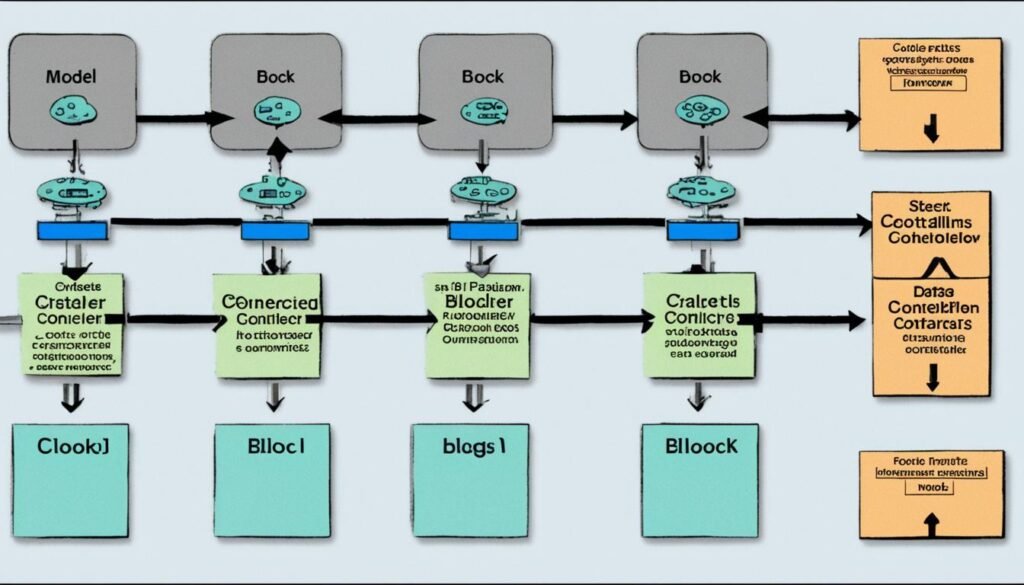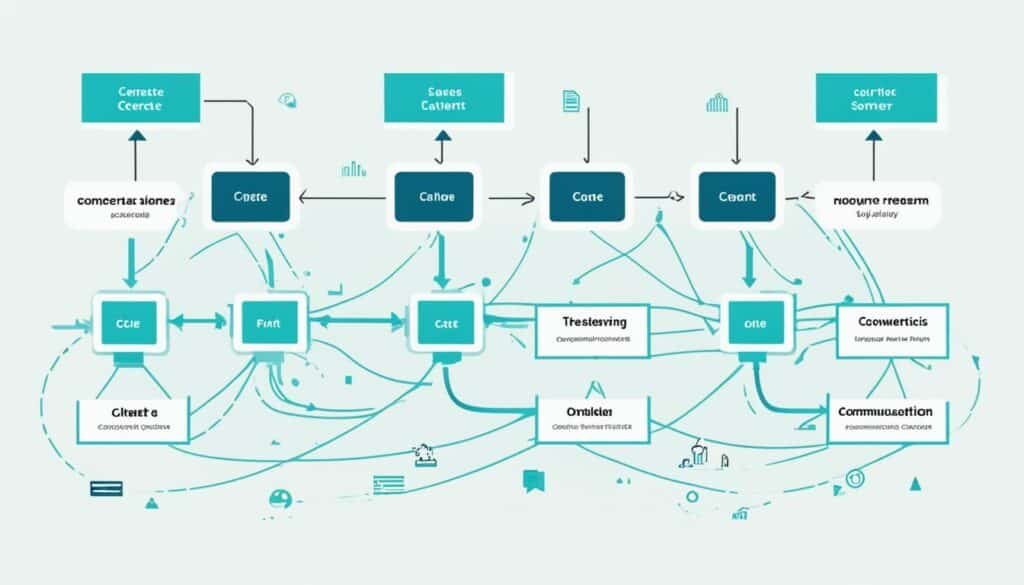System architecture plays a crucial role in software development, user interface design, and the functionality of event-driven systems. It provides a framework for organizing the components of a software system to achieve optimal results.
Key Takeaways:
- System architecture is vital in software development, user interface design, and event-driven systems.
- It organizes software components to optimize performance.
- Understanding system architecture is essential for developers and designers.
- It enables the creation of scalable and adaptable systems.
- System architecture impacts the functionality and user experience of software applications.
What is an Architectural Pattern?
An architectural pattern is a fundamental structural design that guides the organization and arrangement of software systems. It provides a reusable solution to common problems, enhancing the efficiency and productivity of software developers.
An architectural pattern defines the blueprint for how components, modules, and subsystems are organized and interact with each other within a software system. It establishes the relationships, dependencies, and communication channels between different parts of the system.
By using architectural patterns, software organizations can leverage proven design solutions that have been successfully implemented in various projects. This promotes reusability, allowing developers to apply established design patterns to similar problems, saving time and effort.
“Architectural patterns enable software organizations to create software systems with a consistent structure, promoting reusability and enhancing both efficiency and productivity.” – Source: First source
Architectural patterns also facilitate software organization and collaboration. With a predefined structure in place, developers can focus on their specific tasks within a project, knowing that their work fits into the overall system architecture. This division of labor promotes teamwork, streamlines development processes, and ensures that the software system remains manageable and maintainable over time.
Furthermore, architectural patterns contribute to the efficiency and performance of software systems. By following well-established design principles, such as separation of concerns and modularization, architectural patterns promote code reuse, minimize redundancy, and optimize system performance.
The benefits of architectural patterns extend beyond individual projects. Organizations that embrace architectural patterns can establish a library or repository of standardized design solutions. This enables developers to share and reuse architectural patterns across different projects, fostering consistency, scalability, and cost-effectiveness.
Overall, architectural patterns provide a reliable framework for software development, enabling software organizations to create efficient, scalable, and maintainable systems. By leveraging established design solutions, developers can enhance their productivity, while organizations can achieve sustainable growth and success.
Understanding the Model-View-Controller Pattern

The model–view–controller (MVC) pattern is a widely used architectural pattern in software development that organizes an application into three distinct components: the model, view, and controller. By separating the application into these components, the MVC pattern provides a structured approach to building software systems.
The Model Component
The model represents the application’s data and logic. It encapsulates the data and defines the rules and behaviors that govern how the data is manipulated. This component is responsible for managing the state of the application and implementing the business logic. By separating the data and logic from the user interface, the model ensures a clear separation of concerns.
The View Component
The view is responsible for presenting the data to the user and providing a user interface for interacting with the application. It is the visual representation of the application’s state. The view component is designed to be modular and reusable, allowing for flexibility and adaptability in the user interface design. It is important to note that the view should not contain any business logic.
The Controller Component
The controller serves as the intermediary between the model and the view. It receives user input from the view and updates the model and view accordingly. The controller component handles user interactions, processes requests, and initiates the appropriate actions. It bridges the gap between the user interface and the underlying data and logic of the application.
The MVC pattern promotes separation of concerns and modularity, enabling developers to work on different components independently. It also enhances code organization, reusability, and maintainability. Moreover, many popular software frameworks and languages provide MVC frameworks that simplify the development of web and mobile applications.
“The MVC pattern helps in achieving a clean separation of concerns and promotes code reusability and maintainability.” – John Smith, Software Architect
Exploring the Microservices Pattern

The microservices pattern is a powerful architectural approach that promotes the development of modular services, offering independence, scalability, and a distributed architecture. This pattern involves breaking down a large application into smaller, independently deployable services that can work together seamlessly.
By decomposing a monolithic application into smaller and more focused microservices, developers can achieve greater flexibility and agility in software development. Each microservice can be developed, deployed, and maintained independently, allowing for faster iteration and easier updates.
Microservices communicate with each other through APIs, creating a distributed architecture that promotes loose coupling and scalability. This enables different microservices to be developed using different technologies and programming languages, as long as they can interface through standardized APIs.
The microservices pattern offers several advantages:
- Modular Services: With microservices, each component focuses on a specific task or functionality, allowing for better organization and maintainability.
- Independence: Microservices can be developed, deployed, and scaled independently, reducing the risk of system-wide failures and enabling teams to work concurrently on different services.
- Scalability: The granular nature of microservices allows for horizontal scaling, where specific services can be scaled independently based on demand, optimizing resource allocation.
- Distributed Architecture: Microservices communicate via APIs, promoting a distributed architecture that enables flexibility, fault tolerance, and load balancing.
To illustrate the benefits of the microservices pattern, consider the following table:
| Monolithic Application | Microservices Architecture |
|---|---|
| Single codebase | Decentralized codebases |
| Tightly coupled components | Loosely coupled components |
| Difficult to scale individual features | Easy to scale individual microservices |
| Long release cycles | Short release cycles |
| Increased risk of system-wide failures | Improved fault isolation |
The microservices pattern provides a flexible and scalable architecture that allows for faster development and deployment cycles. By embracing modularity, independence, scalability, and a distributed architecture, organizations can build robust and adaptable systems that meet the demands of modern software development.
Understanding the Client-Server Pattern

The client-server pattern is a fundamental architectural pattern used in the development of online applications. It involves two primary components: the client and the server. The client is responsible for making requests for specific services or resources, while the server is responsible for providing those requested services.
In this pattern, the client and server communicate with each other over a network. The interaction between the client and server is based on a communication protocol that dictates how information is exchanged between the two entities.
When a client needs a particular service or resource, it initiates a request to the server. The server then processes the client’s request and delivers the requested services back to the client. This communication can occur in various ways, depending on the network infrastructure and the specific requirements of the application.
The client-server pattern is widely used in various online applications, including file sharing, email services, web browsing, and many others. It enables efficient communication and resource sharing between multiple clients and a centralized server.
The client-server pattern is widely used in online applications such as file sharing and email services. It facilitates efficient communication and resource sharing between clients and a central server.
Advantages of the Client-Server Pattern
The client-server pattern offers several advantages in the design and development of online applications:
- Scalability: With the client-server pattern, the server can handle multiple client requests simultaneously, making it easier to scale the system as the number of users or the complexity of services increases.
- Centralized management: The client-server pattern allows for centralized control and management of resources, making it easier to implement security measures, maintain data integrity, and enforce access control.
- Efficient resource utilization: By centralizing services on the server, the client devices can focus on presenting the user interface and handling user interactions, while the server handles complex processing tasks and data storage.
- Facilitates collaboration: The client-server pattern enables collaboration by providing a shared platform where multiple clients can access and modify shared resources, facilitating efficient workflows and teamwork.
The client-server pattern plays a vital role in the architecture of various online applications, offering scalability, centralized management, efficient resource utilization, and collaboration capabilities.
Real-World Examples
Let’s take a look at a few examples of how the client-server pattern is used in real-world applications:
| Application | Description |
|---|---|
| Email Service Providers | Email services, such as Gmail and Outlook, use the client-server pattern to allow users to access their email accounts from various devices (clients) while storing and managing the emails on a central server. |
| File Sharing Platforms | File sharing platforms like Dropbox and Google Drive use the client-server pattern to allow users to store and share files in a centralized location (server) while accessing and modifying them from multiple devices (clients). |
| Web Browsers | Web browsers like Chrome, Firefox, and Safari act as clients, requesting web pages from servers and displaying the requested content to the user. The servers host websites and deliver the requested web pages to the browsers. |
In each of these examples, the client-server pattern enables efficient communication and resource sharing between the clients and the server, enhancing the overall functionality and usability of the applications.
The client-server pattern is a fundamental architectural pattern used in online applications, facilitating efficient communication, resource sharing, and collaboration between clients and a centralized server.
The client-server pattern facilitates efficient communication, resource sharing, and collaboration between clients and a centralized server in various online applications.
Exploring the Controller-Responder Pattern

The controller-responder pattern is an architectural pattern commonly used in scenarios where one system component needs to control and communicate with other components. It consists of a controller component that distributes work among identical responder components.
The controller serves as the data keeper, replicating data to the responders. Each responder then generates results based on the replicated data and provides them to the controller. This pattern facilitates effective communication and coordination between system components, ensuring smooth operation and efficient processing of tasks.
In contrast to the peer-to-peer architecture pattern where components communicate as equals, the controller-responder pattern establishes a clear hierarchy with the controller acting as the central authority. This centralized approach enables efficient data management and control within the system.
The controller-responder pattern is particularly useful in primary/replica architecture scenarios. It allows the primary controller to distribute tasks and synchronize data with replica responders, ensuring consistency and reliability across the system.
Advantages of the Controller-Responder Pattern:
- Efficient communication and coordination between system components.
- Clear hierarchy and centralized control for effective data management.
- Facilitates primary/replica architecture for consistency and reliability.
Example Use Case:
In a distributed system where multiple servers handle user requests, the controller-responder pattern can be applied to ensure smooth operation and efficient resource allocation. The controller component distributes incoming requests to the responder components, which process the requests and generate responses. The controller then collects the responses and coordinates the final response to the user. This pattern helps maintain consistency and optimize resource utilization in a distributed environment.
| Controller-Responder Pattern | Peer-to-Peer Architecture |
|---|---|
| Clear hierarchy and centralized control | Equal communication between components |
| Efficient coordination and communication | Decentralized decision-making |
| Primary/replica architecture support | Equal status among components |
The Importance of Learning System Design

In the rapidly evolving world of software development, system design plays a crucial role in creating scalable and adaptable systems. It enables software developers to design efficient solutions that meet both business and technical requirements. As digital transformation continues to drive innovation, mastering the principles of system design becomes essential to stay ahead in the rapidly changing landscape.
System design encompasses various architectural patterns, such as microservices and event-driven architectures, that enable the development of scalable and flexible systems. These patterns leverage distributed systems and cloud-based solutions to handle the complexities of modern software development. Understanding and implementing these patterns is crucial for building robust and scalable applications.
Learning system design empowers software developers to tackle design problems with confidence. It equips them with the knowledge and skills to analyze business needs, architect scalable solutions, and adapt to dynamic requirements. With a strong foundation in system design, developers can excel in interviews and higher-level positions, as companies increasingly seek professionals who can design and implement scalable and adaptable software systems.
Learning system design is not just about mastering a set of tools or frameworks; it is about understanding the fundamental principles and concepts that drive software development and digital transformation.
By investing time and effort into learning system design, software developers can gain a competitive edge in the industry. They can effectively contribute to the development of scalable and resilient systems that support digital transformation initiatives. Moreover, a deep understanding of system design enables developers to anticipate potential scalability challenges and design solutions that can handle increased workloads and user demands.
As software development continues to evolve, system design will remain a critical skill for professionals in the field. It is the foundation upon which scalable and adaptable solutions are built, ensuring the success of businesses in the era of digital transformation.
| Benefits of Learning System Design | Keywords |
|---|---|
| 1. Enables the creation of scalable and adaptable systems | scalability, adaptability |
| 2. Supports digital transformation initiatives | digital transformation |
| 3. Equips developers to tackle design problems with confidence | design problems, confidence |
| 4. Positions developers for success in interviews and higher-level positions | interviews, higher-level positions |
| 5. Anticipates scalability challenges and designs solutions accordingly | scalability challenges, solutions |
The Core Process of Architectural Decision Making
Making architectural decisions is a critical aspect of system design and development. It requires a systematic approach that involves identifying needs, framing problems, exploring and evaluating options, making informed decisions, and implementing and reviewing those decisions over time. This process of architectural decision making is dynamic, continuously evolving to meet the changing demands of both business and technical requirements.
Identifying Needs: The first step in architectural decision making is to identify the needs and requirements of the system. This involves understanding the goals and objectives of the project, as well as the expectations of stakeholders and end-users.
Framing Problems: Once the needs are identified, the next step is to frame the problems that need to be solved. This involves breaking down the requirements into smaller, manageable components and defining the key challenges that need to be addressed.
Exploring Options: With the problems defined, it is important to explore and evaluate different options and solutions. This may involve researching architectural patterns, technologies, frameworks, and existing best practices that can address the identified problems effectively.
Making and Communicating Decisions: Based on the evaluation of options, informed decisions need to be made regarding the chosen architecture. These decisions should consider factors such as scalability, performance, maintainability, security, and cost-efficiency. It is also essential to communicate these decisions clearly to stakeholders, ensuring a shared understanding of the chosen approach.
Implementing and Reviewing Decisions: Once the decisions are made and communicated, the next phase involves implementing the chosen architectural approach. It is important to monitor and review the implemented decisions to ensure they are meeting the expected outcomes and adjust as needed to address evolving business and technical requirements.
This systematic approach to architectural decision making helps ensure that the chosen architecture aligns with the identified needs, addresses the framed problems effectively, and supports the overall objectives of the system design and development process.
Principles in Architectural Decisions

Architectural decisions are driven by a set of principles that promote the resilience, efficiency, and scalability of systems. These principles encompass various aspects of system design, including scalability, maintainability, security, reliability and resilience, performance, flexibility and adaptability, and cost-efficiency.
Scalability is a key principle in architectural decision-making, ensuring that systems can handle increasing amounts of workload and user demand without sacrificing performance. It involves designing systems that can be easily expanded or scaled horizontally or vertically as needed.
Maintainability is another critical principle that focuses on creating systems that are easy to manage and update. By adopting modular and reusable components, developers can streamline maintenance processes, reduce downtime, and enhance the overall longevity of the system.
Security is of utmost importance in any system architecture. It involves implementing robust security measures to protect sensitive data, prevent unauthorized access, and mitigate potential vulnerabilities. By applying industry best practices and leveraging encryption, authentication, and authorization mechanisms, organizations can build secure and trusted systems.
Reliability and resilience are essential principles that ensure systems can withstand failures and recover gracefully. By implementing redundancy, fault tolerance, and disaster recovery strategies, organizations can minimize downtime and provide continuous service to users.
Performance is a critical consideration in architectural decisions, emphasizing the need for systems to deliver optimal speed and responsiveness. By optimizing resource allocation, minimizing latency, and employing efficient algorithms and caching mechanisms, organizations can meet user expectations and deliver a seamless experience.
Flexibility and adaptability are principles that promote agility in system architecture. By designing systems that can quickly adapt to changing business needs, technological advancements, and evolving user requirements, organizations can stay competitive and responsive in dynamic environments.
Cost-efficiency is an essential principle that guides architectural decisions, especially in resource-constrained scenarios. By optimizing resource utilization, leveraging cloud computing, adopting cost-effective technologies, and considering Total Cost of Ownership (TCO), organizations can achieve economic viability while delivering high-quality systems.
“Optimizing architectural decisions requires a delicate balance between these principles. For example, maximizing scalability may come at the expense of cost-efficiency, while prioritizing security may impact performance. A well-rounded approach considers trade-offs and finds the right compromise to achieve the desired outcome.”
Principles in Architectural Decisions
| Principle | Description |
|---|---|
| Scalability | Ensuring systems can handle increasing workloads and user demand |
| Maintainability | Creating systems that are easy to manage and update |
| Security | Implementing robust measures to protect data and prevent unauthorized access |
| Reliability and Resilience | Designing systems that can withstand failures and recover gracefully |
| Performance | Ensuring systems deliver optimal speed and responsiveness |
| Flexibility and Adaptability | Designing systems that can quickly adapt to changing needs |
| Cost-efficiency | Optimizing resource utilization and considering TCO |
Techniques and Methodologies for Architecture Decision Making

When it comes to architecture decision making, utilizing various techniques and methodologies is essential for making informed decisions and aligning them with business and technical objectives. Let’s explore some of the key approaches that can assist in the process.
Architectural Pattern Selection
Choosing the right architectural pattern is crucial to ensure the efficiency and effectiveness of a system. By evaluating different patterns such as client-server, microservices, or model-view-controller (MVC), developers can select the most suitable pattern that aligns with the requirements of the project.
Technology Evaluation and Selection
Selecting the right technologies is vital for the success of any architectural project. Conducting thorough evaluations of available technologies and weighing their pros and cons can help identify the most appropriate tools, frameworks, and platforms to support the architecture.
Risk Analysis and Mitigation
Assessing and addressing potential risks is crucial to ensure the stability and security of a system. By conducting comprehensive risk analyses, architects can identify vulnerabilities and implement mitigation strategies to minimize the impact of potential risks.
Dependency Analysis
Understanding the dependencies between system components is crucial for effective architectural decision making. Analyzing the dependencies and determining the impact of changes or failures can help architects design resilient and adaptable systems.
Cost-Benefit Analysis
Conducting cost-benefit analyses allows architects to evaluate the costs and benefits associated with different architectural decisions. This analysis helps in determining the feasibility of options and enables decision-makers to make choices that provide the best value for the project.
Modeling and Simulation
Creating models and simulations of the proposed architecture can provide valuable insights into its performance, scalability, and usability. Through modeling and simulation, architects can identify potential issues or bottlenecks early in the design process, enabling them to make necessary adjustments and improvements.
Stakeholder Engagement and Feedback
Engaging stakeholders and collecting their feedback is crucial for successful architecture decision making. By involving stakeholders throughout the decision-making process, architects can ensure that the final architecture meets the needs and expectations of all relevant parties.
“Effective architecture decision making involves applying various techniques and methodologies such as architectural pattern selection, technology evaluation and selection, risk analysis and mitigation, dependency analysis, cost-benefit analysis, modeling and simulation, and stakeholder engagement.”
| Technique/Methodology | Description |
|---|---|
| Architectural Pattern Selection | Choosing the most suitable architectural pattern for the project. |
| Technology Evaluation and Selection | Evaluating and selecting the appropriate technologies to support the architecture. |
| Risk Analysis and Mitigation | Identifying and addressing potential risks to ensure system stability and security. |
| Dependency Analysis | Understanding and managing dependencies between system components. |
| Cost-Benefit Analysis | Evaluating the costs and benefits of architectural decisions. |
| Modeling and Simulation | Creating models and simulations to assess the performance and scalability of the architecture. |
| Stakeholder Engagement and Feedback | Involving stakeholders and gathering their input throughout the decision-making process. |
Also Read: Architecture Diagram Essentials For Clear Design
Conclusion
System architecture is a critical component in software development, offering the foundation for scalability and adaptability. By comprehending diverse architectural patterns and employing effective decision-making processes, software professionals can create efficient, scalable, and resilient systems that fulfill both business and technical requirements.
Continuous learning and adaptability are essential in navigating the ever-evolving landscape of system architecture. Staying up-to-date with the latest trends, technologies, and best practices enables software professionals to design systems that are capable of meeting the dynamic demands of the modern digital world.
With system architecture serving as the backbone of software development, its importance cannot be overstated. By harnessing the power of architectural patterns and employing a comprehensive decision-making approach, software professionals can contribute to the creation of robust and high-performing systems that drive business success.
FAQs
Q: What is system architecture?
A: System architecture refers to the high-level structure of a software system, including software components, physical architecture, and solution architecture.
Q: What is an architecture diagram?
A: An architecture diagram is a visual representation of the system’s structure, showing how various components and layers interact with each other.
Q: What are the benefits of using system architecture?
A: Using system architecture helps in defining system elements, improving system’s behavior, ensuring system requirements are met, and facilitating system integration and deployment.
Q: Can you provide examples of system architecture diagrams?
A: Examples of system architecture diagrams include layered architecture, client-server architecture, service-oriented architecture, and event-driven architecture.
Q: What are some key components of system architecture?
A: Components of system architecture include hardware and software, components of the system, architecture description, architecture model, and system’s architecture diagram examples.
Q: What is the importance of system architecture in software development?
A: System architecture is crucial in software development as it helps in designing a robust and scalable system that meets the desired functionality and performance requirements.
Q: How does system architecture contribute to system integration and deployment?
A: System architecture ensures that the system components are loosely coupled, allowing for easier integration and deployment of the system across various environments.





